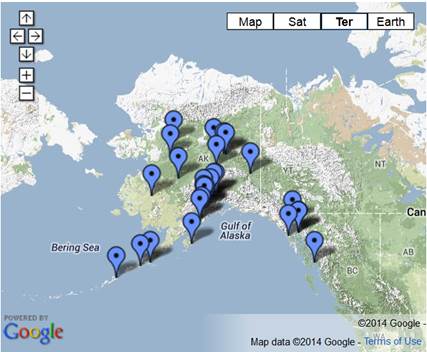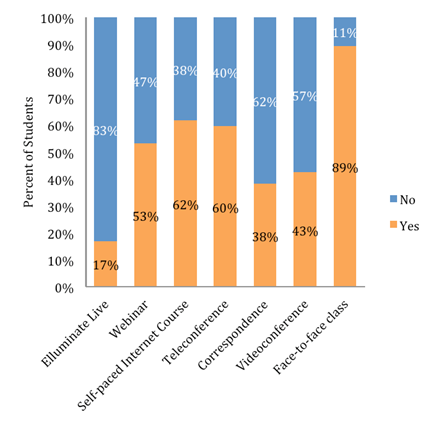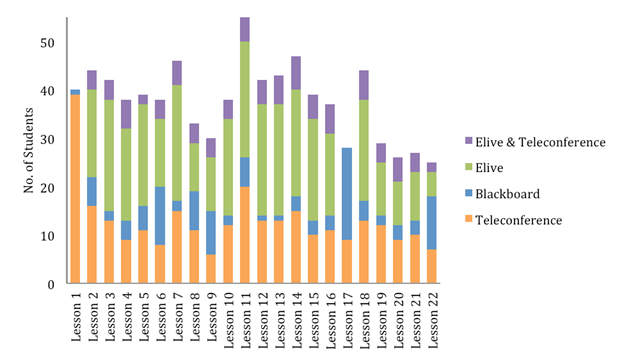 |
February 2015
|
February 2015 // Volume 53 // Number 1 // Research In Brief // v53-1rb2
Going the Distance Part 3: Teaching an Extension Course Using a Combination of Distance-Delivery Methods
Abstract
Extension could rely more on distance education to expand its outreach with deflating budgets. In Alaska, where people are few and far between and even inaccessible by road, opportunities for distance-delivered outreach are particularly significant. In this article, we explore the efficacy of a mixed-method teaching approach that combined three distance-delivery methods: Elive, Blackboard, and teleconference. We share course impacts, completion rates, and satisfaction. We surmise that providing more than one way for students to participate in a distance course increases student satisfaction.
Introduction
As Cooperative Extension Service budgets shrink, Extension agents should rely more on technology (Bowen-Ellzey, Romich, Civittolo, & Davis, 2013), including distance-delivery technology, to reach its clientele. Franz and Cox (2012) stated that, "Extension must more fully and adeptly embrace disruptive innovation as a way to thrive rather than to cling to old ways of operating. Discovering, implementing, and evaluating disruptive innovations may be the tipping point for survival of Cooperative Extension" (Summary section, para.1).
Nationwide, the percentage of post-secondary students enrolled in at least one online class has increased from 10% in 2002 to 32% in 2011 (Allen & Seaman, 2013). In spite of this upward trend in other education sectors, Dromgoole and Boleman (2006) found Extension agents hesitant to offer distance-delivered courses because of concerns for their clientele's acceptance of, access to, and ability to use distance technology; as well as the absence of face-to-face interaction. But Franz, Piercy, Donaldson, Westbrook, and Richard (2010) found that farmers were more inclined to learn online than Extension agents thought they were. Parker (2009) also found clientele perceived a distance-delivered class more favorably compared with Extension agents and wished more Extension courses were offered by distance. Others found that the combination of online and mail distance-delivery methods was comparable in effectiveness to face-to-face instruction (Campbell, Koszewski, & Behrends, 2013). Clearly, distance education is a trend that Extension can't ignore.
Purpose
In 2011, Alaskan Growers School (AGS) was taught using five, discrete, delivery methods (Elive, Blackboard, teleconference, correspondence, or face-to-face), which were described in detail by Rader, Hanna, Spiers, and Kienenberger (2014). Based on lessons learned from offering the course in 2011, we developed a mixed-method teaching approach using Elive, Blackboard, and teleconference to teach AGS a second time (2012 – 2013). In this article, we describe and report on evaluation of this mixed-method approach.
We asked:
- When given the option to choose from three distance-delivery methods, which method (s) did students choose to use to access the course?
- Did this teaching approach positively impact students in terms of change in knowledge, skills acquisition, and planned behavior change?
- Were students satisfied with the teaching approach?
- Was the mixed-method delivery approach cost-effective?
We hope our description and evaluation of a mixed-method distance education approach will be used by other Extension professionals to aid in designing distance-delivered courses.
Methods
Course Description
The AGS <www.uaf.edu/ces/ags> consisted of the Beginning Alaskan Growers School (BAGS; Lessons 1 to 10) and the Advanced Alaskan Growers School (AAGS; Lessons 11 to 22). After enrolling students initially in AGS, we found many failed to complete even the first section of the course (BAGS), and so we recruited and enrolled additional students in the second section of the course (AAGS) so that we had a full class. Because of the different cadre of students in each section of the course, results are differentiated for BAGS and AAGS. The intent of the course was to teach students the knowledge and skills needed for subsistence agriculture or small-scale, commercial agriculture. Instructors used Elluminate Live! (Elive; a type of webinar) and teleconference (Figure 1) to present once a week (Wednesdays) from 5:30 to 7:30 p.m. Instructors presented a peer-reviewed PowerPoint presentation; assigned readings, optional reading material, and recorded presentations were accessible anytime via Blackboard (classroom portal).
Figure 1.
Donavan Kienenberger and Heidi Rader Presented a Lesson for the Alaskan Growers School Using Elive And Teleconference

Data Collection
Students self-administered the following questionnaires and quizzes using Google Forms © online. This project was reviewed and approved by the Institutional Review Board at the University of Alaska Fairbanks.
Questionnaire and Quiz Description
- AGS Application: Potential participants in AGS completed the application, which included questions about farming experience and access to technology.
- Pre-quizzes: We asked questions about the content to be covered to gauge students' knowledge before participating in BAGS and AAGS. Content-based questions were repeated in weekly course quizzes to determine if the number of correct answers increased after participating in the lesson addressing that information. We also asked what students hoped to learn in AGS and about education level, and prior gardening, computer, and distance education experience.
- Weekly Course Quizzes consisted of:
- Three questions about the content covered in that week's presentation to assess knowledge gain (with a right or wrong answer);
- Four retrospective, pre-post questions to assess self-perceived knowledge gain on a Likert scale (1 = minimal to 4 = considerable); and
- Five questions to assess students' plans to use skills.
- Final Quizzes: In addition to questions asked in weekly quizzes about Lessons 10 and 22, students were also asked about each of the sections, BAGS and AAGS, as well as the overall Alaskan Growers School. Quiz 10 was the final quiz in BAGS, and Quiz 22 was the final quiz in AAGS.
For BAGS, there were nine weekly quizzes (self-administered after Lessons 1-9), and in AAGS there were 11 weekly quizzes (self-administered after Lessons 11-21).
Google Forms provided summary statistics and we downloaded the data to Microsoft Excel for additional analysis.
Results
Student Characteristics
Sixty-four students were enrolled in BAGS and 69 were enrolled in AAGS. The majority of BAGS students were college graduates (66%) and had gardened the summer prior to the course (74%). An equal portion of students (45%) rated their computer skills considerable or moderate, while 11% rated their skills as minimal. No one said their computer skills were non-existent. Students participated from all over Alaska (see Figure 2) with a wide experiential and educational background.
Figure 2.
Students' Locations (29 Communities) for the Alaskan Growers School (BAGS and AAGS) Taught Using a Mixed-Method Delivery Approach. Map data ©2014 Google

Figure 3 shows students' previous experience with various education methods. More than half of students had previously participated in a webinar, but only 17% had used Elive, the specific type of webinar used in AGS. Less than half of students had previously participated in a course taught by either videoconference (43%) or correspondence (38%).
Figure 3.
Beginning Alaskan Growers School (BAGS) Students' (N=47) Prior Participation in Various Education Methods, in Particular, Distance-Education Methods

We also asked BAGS students what they hoped to learn in AGS (Figure 4). Learning about gardening was very important to every student (100%). Growing enough food for 10 other families and because it was fresher were very important to 79% and 87%, respectively. Notably, selling produce in other communities and employment in agriculture were least important.
Figure 4.
The Importance of Different Learning Outcomes to BAGS Students (N=47)

Quiz Completion
Of the 64 students enrolled in BAGS, 47 completed the pre-quiz (87%), and 36 completed the final quiz (56%). Of the 69 students enrolled in AAGS, 37 completed the pre-quiz (54%), and 25 completed the final quiz (36%).
Weekly Attendance
Figure 5 offers a glimpse into how students chose to attend class given the option of Elive, teleconference, or Blackboard. Overall, Elive was the most popular way of participating in AGS. For BAGS, weekly attendance ranged from a low of 26 students (Lesson 9) to a high of 46 students (Lesson 7). The first AAGS class (Lesson 11) was the most well attended class of AGS (55 students), while the last AAGS class was the least well attended (25 students) of AGS. All students used Blackboard to access additional reading material and quizzes, but in some weeks, a few students missed a live class and participated in the course solely using Blackboard. These students were recorded as having attended via Blackboard. There was at least one student who completed the course using only Blackboard. Each week, some students took advantage of the higher audio quality of the teleconference, while also participating via Elive. They are shown as having attended via Elive and Teleconference. There were two weeks (Lesson 1 and 17) where the Elive platform was unavailable, and therefore students could only participate by teleconference and/or Blackboard.
Figure 5.
Weekly Attendance, by Method, in BAGS (Lessons 1 - 10) and AAGS (Lessons 11 - 22)

Knowledge Gain
Consistently, students answered more content-based questions correctly after participating in the associated lesson than before (Figure 6). On average, for BAGS and AAGS, 22% and 17% more students answered questions correctly after completing the associated lesson, respectively. Content questions were asked before BAGS (N=47) and AAGS (N=37) in pre-quizzes, and again after each lesson. The number of students who completed the quizzes after each lesson (N) were 51, 48, 48, 38, 41, 38, 39, 40, 39, 35, 34, 34, 34, 32, 31, 26, 26, 26, 25, 25, and 25, for lessons 1-22 (except Lesson 18), respectively. The content questions relating to lesson 18 were not asked on the AAGS pre-quiz, and so that data is not shown.
Figure 6.
The Average, Percent of Answers Correct, Before and After Each Lesson in AGS

Overall, BAGS students (N=35) rated their knowledge as 3.3 (moderate) after the class compared with 2.2 (minimal) before the class (Figure 7). Similarly, after completing AAGS (N=25), students, overall, rated their knowledge higher (3.3; moderate) than before (2.1; minimal). One retrospective, pre-post question was asked about each lesson in BAGS on Quiz 10 (N=35) and AAGS on Quiz 22 (N=25).
Figure 7.
Mean Self-Perceived Knowledge Before and After Each Lesson

Plans to Use Skills
We asked students about their plans to use skills they had learned in the course (Figure 8). Additionally, they were asked if they already did something before the class, began during class, or had no plans to use a particular skill.
Figure 8.
Students' Plans to Use Skills (N=25), After Completing AAGS (A Selection of the Questions Asked in the AAGS Final Quiz)

Student Satisfaction
Students were asked to rate BAGS and AAGS, overall, as a learning experience, given the following choices: very poor, poor, neither good nor poor, good, and very good. Forty-three percent of BAGS students (N=35) rated the course very good, 51% good, and 6% neither good nor poor. After completing AAGS (N=25), students rated the course slightly higher, with 64% choosing very good, 32% good, and one student rating the class as neither good nor poor. No one in AGS rated the course poor or very poor.
We also asked students to rate the importance of various aspects of the course. After completing BAGS (N=35), more than 30 students rated course readings, presentations, delivery method, and guest lecturers as very important; 25 to 30 students rated the instructor and links to outside material s very important; and 10 to 15 students rated discussions after class and quizzes as very important. After completing AAGS (N=25), more than 20 students rated the delivery method, presentations, and links to outside material as very important; 15 to 20 students rated guest lecturers and the instructor as very important; and only five to 10 students rated the discussions after class and course quizzes as very important. The distance-delivery method was rated by more students as very important than any other aspect of the course. Also rated very important by most students in BAGS and AAGS was the course material and links to outside material.
We also asked students an open-ended question regarding what they liked least and most about the course. In general, students had more positive than negative comments. Some student feedback conflicted with that of other students. Many students particularly enjoyed the social interaction offered by Elive, which allowed students to chat online with the group or with individuals. For example, one student said, "I loved the pace, the interaction with other classmates during lecture and ability to share our experiences from a large geographic area and growing...zones." In contrast, one student said, "I liked the content most and it was very flexible. I felt better when I did the classes on my own. I was very intimidated by the experience of my classmates and just listened."
Cost to Deliver
The primary cost of delivering this course was instructor time. By offering AGS by distance-delivery, we did not incur travel, printing, postage, or classroom space expenses. The cost per additional student was minimal.
Discussion
We described and evaluated a combination of distance-delivery methods (Elive, Blackboard, and teleconference) to teach an intensive course for beginning farmers. Based on weekly attendance numbers (Figure 5), students preferred to access the course by Elive followed by teleconference. In terms of quiz completion and weekly attendance, many students failed to attend and complete the course. Forty-four percent of BAGS students and 64% of AAGS students dropped out (defined as the percentage of students enrolled in BAGS and AAGS who failed to complete the final quiz of each section of the course). However, students who did participate in the course planned to use the skills acquired, gained knowledge in a variety of areas, and rated the course, overall, favorably.
A troublesome question remains: why did so many students drop out? Likely, there were a number of factors influencing participation in AGS—some related and others not to how the course was delivered. Possible disincentives to participation unrelated to delivery method were that AGS was too long (at least 22 weeks), not for credit, and offered at an inconvenient time. While possible disincentives related to the distance-delivery method were difficulties in using and accessing the technology and a lack of face-to-face interaction. The fact that the course was offered for free could've been both an incentive and disincentive. More people may have initially signed up because it was free but then might have been less committed because they had no financial investment in the course. To verify which factors were most important, we should have surveyed students who dropped out. However, this could have proved problematic as many hadn't completed even one quiz.
In our opinion and based on student feedback, our course was high quality. There was high demand for the course, and the distance-delivery method proved satisfactory. These were three keys to a successful distance-delivered Extension course identified earlier (Rader, 2012). By using a combination of three distance delivery methods we offered a more flexible learning environment and expanded our outreach potential. We think that the continued evaluation of distance-delivery methods in an Extension setting will improve perceptions and increase the use of distance education in Extension.
Acknowledgements
This project was supported by the Beginning Farmer and Rancher Development Program of the National Institute of Food and Agriculture, USDA, Grant # 2010-49400-21719. Any opinions, findings, conclusions, or recommendations expressed in this publication are those of the author and do not necessarily reflect the view of the U.S. Department of Agriculture.
References
Allen, E., & Seaman, J. (2013). Changing course: Ten years of tracking online education in the United States. Retrieved from: http://www.usdla.org/research-center/
Bowen-Ellzey, N., Romich, E., Civittolo, D., & Davis, G. (2013). Change is inevitable: How Field Specialist positions can help meet the challenge. Journal of Extension [On-line], 51(3) Article 3COM1. Available at: http://www.joe.org/joe/2013june/comm1.php
Campbell, C., Koszewski, W. M., & Behrends, D. (2013). The effectiveness of distance education, using blended method of delivery for limited-resource audiences in the nutrition education program. Journal of Extension [On-line], 51(4) Article 4FEA4. Available at: http://www.joe.org/joe/2013august/a4.php
Dromgoole, D. A., & Boleman, C. T. (2006). Distance education: Perceived barriers and opportunities related to Extension program delivery. Journal of Extension [On-line], 44(5) Article 5RIB1. Available at: http://www.joe.org/joe/2006october/rb1.php
Franz, N. K., & Cox, R. A. (2012). Extension's future: Time for disruptive innovation. Journal of Extension [On-line], 50(2) Article 2COM1. Available at: http://www.joe.org/joe/2012april/comm1.php
Franz, N. K., Piercy, F., Donaldson, J., Westbrook, J., & Richard, R. (2010). Farmer, agent, and specialist perspectives on preferences for learning among today's farmers. Journal of Extension [On-line], 48(3) Article 3RIB1. Available at: http://www.joe.org/joe/2010june/rb1.php
Parker, R. T. (2009). Distance education: Taking the first steps. Journal of Extension [On-line], 47(3) Article 3IAW5. Available at: http://www.joe.org/joe/2009june/iw5.php
Rader, H. B., Hanna, V., Spiers, K., & Kienenberger, D. (2014). Going the distance part 2: Comparing five ways of teaching an Extension course. Journal of Extension [On-line], 52(6) Article 6FEA3. Available at: http://www.joe.org/joe/2014december/a3.php
Rader, H. B. (2012). Going the distance part 1: Three keys to successfully delivering an Extension course at a distance. Journal of Extension [On-line], 50(6) Article 6TOT4. Available at: http://www.joe.org/joe/2012december/tt4.php




